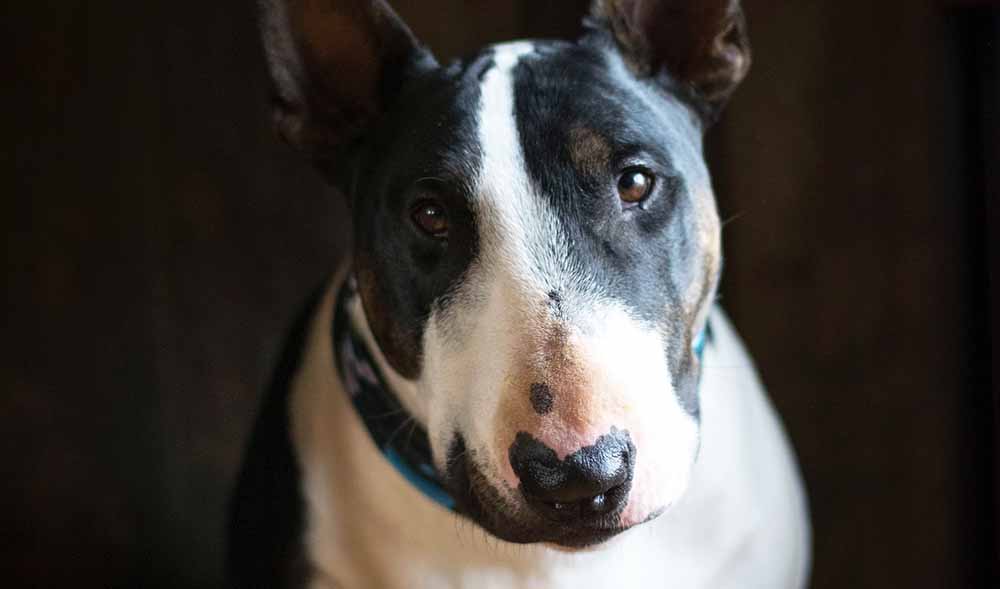
This article was updated on March 30th, 2022
Choosing the right time to euthanize a dog because of kidney failure is without a doubt the hardest decision any owner will have to make. As a veterinarian, I often have to talk through these situations with dog owners.
Let me start with an example that may help you in your decision-making: I had been treating Milo, a 13-year-old Bull terrier, who was diagnosed with renal disease 2 years ago. Unfortunately, we recently had to come to the difficult conclusion to put Milo to sleep.
The Story of Milo & His Kidney Failure
Milo, a Bull Terrier, was first diagnosed with kidney disease when his owners noticed that the amount he was drinking and urinating had been increasing over time. When Milo came in to see me I analyzed his urine and performed a blood test and confirmed the diagnosis of chronic kidney disease. At this point, he was deemed to be in the early stages of the disease process.

Milo was immediately put on a special renal diet; regular blood tests were performed and his urine was analyzed every few months. Milo went on to live a very happy and normal few years, the only real difference in his life being a stricter diet.
However, in the last 6 months of his life, Milo did begin to slow down. Symptoms such as lethargy and vomiting, which the owners put down to old age at first, were in fact signs of Milo going into the later stages of kidney failure.
When Was the Decision Made to Euthanize Milo Because of his Kidney Failure?
In the week that I last saw Milo, he was a completely different dog what his owners and I were used to. He looked depressed, lethargic and would urinate on an almost hourly basis. A blood test did in fact confirm that he was in end-stage kidney failure to which unfortunately there was no treatment option.
Milo’s owners knew it was the right time to have him put to sleep because:
- There was no longer a treatment option that could help.
- Milo appeared depressed or lethargic, meaning his quality of life was low.
- He struggled with basic everyday needs including urination and eating.
The owners couldn’t bear to see him continue to deteriorate. He had lived a wonderful life and his owners took comfort in the fact that he had still managed to live 2 happy years since being diagnosed with chronic kidney disease.
When is The Right Time To Euthanize a Dog Due to Kidney Failure?
If your dog has recently been diagnosed with chronic kidney disease and is showing advanced symptoms, you might be worried about the right time to euthanize your dog.
Kidney failure is a disease that can gradually sneak up on dogs and some owners may not notice symptoms until later in the disease process.
Other dogs may suddenly become unwell as their renal function very suddenly deteriorates. Although kidney disease is a condition I see commonly as a vet, every case is different and so there is no hard and fast rule as to when to have an affected dog put to sleep.
The right time to euthanize a dog with kidney disease is when:
1) your veterinarian has tried all medical options
2) your dog is near the stage of kidney failure
3) your dog no longer enjoys a good quality of life
As a result, it is important to know the treatment options that are available, the average survival rates, and when your dog is nearing the stage of final kidney failure. We will then review simple questions to evaluate your dog’s quality of life.
| Last Days of a Dog with Kidney Failure: |
| – Dog may begin to slow down (lethargic or depressed) |
| – Dog is struggling with basic everyday needs (eating, urinating, moving) |
| – There are no longer any treatment options to help |
| – The dog may show other severe clinical symptoms such as vomiting, ulceration of the gums, and dramatic weight loss |
What Is the Survival Rate for Dogs with Kidney Disease?
If you are wondering when is the right time to euthanize your dog because of kidney disease, you are probably wondering about survival rates: is your doing going to be able to get better to live a comfortable life? Or will the situation deteriorate quickly, leaving your dog with low chances at getting back to the happy and comfortable life he was used to? Looking at our data about survival rates may help in your decision.
Vets use a grading system known as the IRIS staging guidelines to describe what stage of renal disease your dog is in. These guidelines use a range of variables to determine how far advanced kidney disease is, including blood markers, urine protein levels, blood pressure and symptoms. Staging ranges from 1-4, with stage 4 the most severe life-threatening state.
The prognosis for dogs with kidney disease is correlated to the severity of the disease and the IRIS stage in which they fall under. Dogs in higher IRIS stages have shorter median survival times. According to one study, the overall median survival time from point of diagnosis is 226 days.
Median Survival times corresponding to different IRIS stages are as follows:
- Stage 1: Over 400 days
- Stage 2: 200-400 days
- Stage 3: 110-200 days
- Stage 4: 14-80 days
As you can see the sooner that kidney disease is detected and treatment started, the better the outcome. If detected in the early stages of the disease, a dog can live for 1-2 more years with the right management – as was the case of Milo mentioned at the start of this article.
However, if detected late in the disease process then the prognosis is poor and survival time may only be a matter of weeks to months. If your old friend is in the advanced stages of kidney failure with a poor quality of life, you should consider euthanasia to prevent unnecessary suffering.
What Treatment is Available for Chronic Kidney Disease in Dogs?
Before making a decision to euthanize a dog because of kidney failure, it is important to understand which treatment options are available and how these treatments can improve your dog’s quality of life and life expectancy.
Unfortunately, Chronic Kidney Disease is not a curable disease. As I mentioned above, much of the damage to the kidneys is already done by the time your dog shows symptoms, and due to the lack of the kidneys’ ability to repair themselves this damage is irreversible.
All hope is not lost however as there are plenty of things that both an owner and vet can do to help slow down the disease process.
The most important form of management of chronic kidney disease is through changing your dog’s diet. Since the kidneys excrete excess waste proteins from the body in the form of urea, a low protein diet can help lessen the load.
Renal diets are specially designed to have low levels of high-quality proteins so that the amount the body wastes is minimized. These diets are also low in phosphate, a mineral that diseased kidneys struggle to excrete. It’s very important that your dog exclusively eats only their renal diet once they have been diagnosed; you might think you’re doing your dog a favor by giving him a meaty treat but this only speeds up their renal disease.
Your vet may also be able to prescribe medications that can help with the side effects of kidney disease such as blood pressure medication and phosphate binders. If your dog has taken a really bad turn then it’s likely the levels of toxins in their blood have risen to dangerous levels.
Your vet may want to give your dog intravenous fluids to try and flush these toxins through their system and while this isn’t a long-term solution it can help stabilize a critically ill renal patient.
If your dog is responding to these medical treatments, it might be too soon to euthanize a dog with kidney disease.
Is Your Dog In the Final Stage of Kidney Failure?
The first step when making the decision whether to euthanize your dog with kidney disease is to understand if they have entered kidney failure.
As we have discussed, CKD is a gradual process and many dogs will cope surprisingly well as their kidneys have a large amount of residual function. However, once 2/3 of their kidney tissue is damaged they can very quickly deteriorate as there is not enough functioning tissue left to filter toxins out of the bloodstream. It is at this point that a dog has entered kidney failure; they begin to display severe clinical symptoms such as vomiting, depression, ulceration of the gums, and dramatic weight loss.
One option if your dog gets to this point is to take them to the vets for intravenous fluid therapy. Sometimes a few days of fluids to flush any toxins out of the system can boost them back to a manageable point.
However, if this has little effect and their parameters are still high on a blood test after this treatment then it might be time to consider euthanasia.
Questions to ask yourself To Evaluate Your Dog’s Quality of Life
Ask yourself the following questions when considering whether to have your dog with kidney disease put to sleep:
- Does your dog seem happy and interested in their favorite things?
- Does your dog still have a good appetite?
- Does your dog have frequent vomiting and/or diarrhea?
- Is your dog drinking and urinating an excessive amount?
- Does your dog have bad breath or ulceration on their gums?
- Is your dog losing a dramatic amount of weight?
If you come to a negative conclusion after asking these questions then it might be time to consider euthanasia. You can also take our Quiz: It is time to euthanize or put my dog to sleep?
Try to put yourself in your dog’s shoes; does your dog have any quality of life? Or are they simply just existing? Dogs in end-stage renal failure likely feel nauseous and weak most of the time and so it isn’t fair to keep them alive in this state.
While it’s a devastating decision for any owner to have to make, you must do what’s right for your dog. The ability to perform euthanasia is a blessing, if dogs with kidney failure couldn’t be put to sleep then they would meet a very unpleasant fate.
Steps to Take Before you Decide to Euthanize your Dog
Before you decide to euthanize your dog because of kidney failure or disease, we recommend that you follow these steps:
- Talk to your vet – Questions to ask your vet to help with the decision to euthanize your dog include:
- What stage of kidney disease is my dog in?
- What treatment options are available?
- What is their survival rate and life expectancy with and without treatment?
- What symptoms should I look out for that might mean my dog needs euthanizing?
- Is my dog suffering?
- Evalute your dog’s quality of life: take our quiz to help evaluate your dog’s quality of life.
- If you have concluded that euthanasia is the best thing for your dog because of kidney failure, ask your vet what the process entails. Most veterinary clinics will allow the owner to be with their dog at the time of passing and some may even be able to arrange a home visit to allow your dog to be as comfortable as possible. Being prepared for what the euthanizing process involves will prevent any shocks or anxiety leading up to the event; that way you can concentrate on being there for your canine friend.
Learn more with our article about Putting Your Dog To Sleep: 8 Important Things to Know
FAQ About Kidney Disease in Dogs
What is Kidney Failure?
Kidney failure is the end-stage of chronic kidney disease (CKD), a gradual deterioration in the function of the kidneys over time. The role of the kidneys is to remove the toxic waste products of metabolism from the bloodstream, particularly urea which is a breakdown product of unneeded proteins in the diet.
These waste products are then excreted as urine. The kidneys are also vital in regulating electrolyte levels and helping your dog conserve water in times of potential dehydration.
CKD is the result of the gradual aging of the kidneys – over time this pair of organs becomes less efficient at their job and so toxic waste substances accumulate in the blood, this damages the kidneys and sets up a vicious cycle. The kidneys have a great reserve capacity – that means that even if a significant portion of the renal tissue is damaged they can still do their job.
However, unfortunately, any damage done is irreversible and eventually, the kidneys can no longer keep up with the body’s demands. Furthermore, clinical symptoms of renal disease are usually not displayed by your dog until about 2/3 of the kidney tissue is dysfunctional, so any damage done has often been accumulating for months or years before it can be detected.
What are the Symptoms of Kidney Disease in Dogs?
The symptoms your dog displays will depend on the stage of chronic kidney disease that they are in. Common symptoms include:
- Increase in thirst
- Increase in urination frequency and/or volume
- Lethargy
- Vomiting and diarrhoea
- Reduced appetite
- Ulceration to gums
- Bad breath
- Weight Loss
- Anaemia (pale gums)
While a dog can display many of these symptoms at any stage of kidney disease, vomiting and ulceration to the gums often only occur in very late renal failure when the dog enters a state known as uraemia.
.
Disclaimer: This website's content is not a substitute for veterinary care. Always consult with your veterinarian for healthcare decisions. Read More.


Be the first to comment